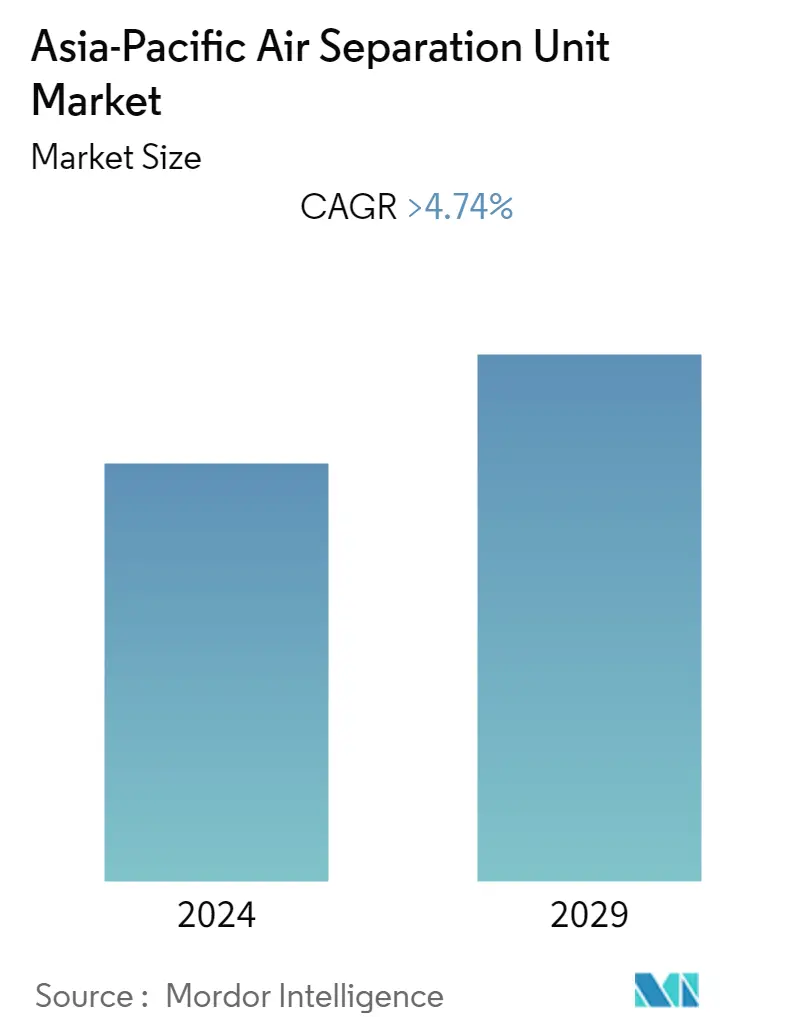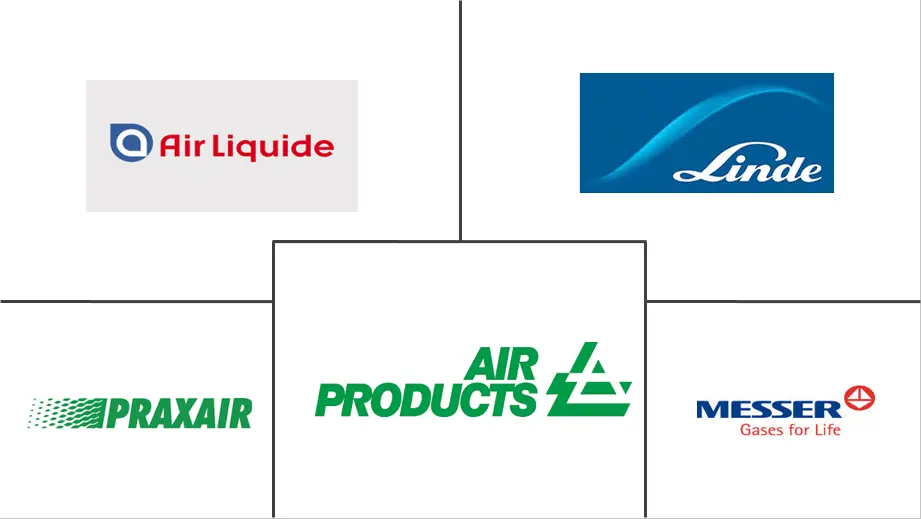Market Size of Asia-Pacific Air Separation Unit Industry

| Study Period | 2020 - 2029 |
| Base Year For Estimation | 2023 |
| Forecast Data Period | 2024 - 2029 |
| Historical Data Period | 2020 - 2022 |
| CAGR | > 4.74 % |
| Market Concentration | High |
Major Players
*Disclaimer: Major Players sorted in no particular order |
Asia-Pacific Air Separation Unit Market Analysis
The r Asia-Pacific air separation unit market is expected to record a CAGR of more than 4.74% during the forecast period of 2020 - 2025. The increasing infrastructure development activities, particularly in China and India, have resulted in the growth of the iron and steel sector. This is expected to promulgate the air separation unit market in the Asia-Pacific region, during the forecast period. The price point of industrial gases in India is the lowest in the Asia-Pacific region, due to a large number of local players in the country. Due to stiff competition, the price point of industrial gases is very low, thereby, leading to reduced profit margins for the companies. Due to the aforementioned factor, the industrial gases sector in India may witness a recession. Moreover, the COVID-19 pandemic has slowed down many industrial activities owing to the increased infection rate, country shutdowns, and transportation halts across the nation. Thus, this is expected to decrease the new investment rate, which, in turn, is likely to hinder the growth of the market studied.
- The chemical industry accounted for the significant market share in the air separation unit market in 2019, owing to the increasing demand for chemicals and commissioning of new ASUs.
- Many countries across the region are developing new industrial zones to promulgate economic development. Therefore, the policy level initiatives to drive industrial growth are expected to create significant opportunities for the air separation unit market in Asia-Pacific in the near future.
- China is expected to dominate the market over the forecast period owing to the rapid industrialization in the country.
Asia-Pacific Air Separation Unit Industry Segmentation
The Asia-Pacific air separation unit market report includes:
| Process | |
| Cryogenic Distillation | |
| Non-cryogenic Distillation |
| Gas | |
| Nitrogen | |
| Oxygen | |
| Argon | |
| Other Gases |
| End User | |
| Oil and Gas Industry | |
| Steel Industry | |
| Chemical Industry | |
| Food and Beverage Industry | |
| Healthcare Industry | |
| Other End Users |
| Geography | |
| Japan | |
| China | |
| India | |
| Rest of Asia-Pacific |
Asia-Pacific Air Separation Unit Market Size Summary
The Asia-Pacific air separation unit market is poised for growth, driven by infrastructure development and industrialization, particularly in China and India. The region's burgeoning iron and steel sector is a significant contributor to this expansion. However, the market faces challenges such as low industrial gas prices in India due to intense local competition, which may impact profit margins and potentially lead to a recession in the industrial gases sector. The COVID-19 pandemic has also slowed industrial activities, affecting investment rates and hindering market growth. Despite these challenges, the chemical industry remains a major player in the air separation unit market, with increasing demand for industrial gases like oxygen and nitrogen, essential for various chemical processes and fertilizer production.
China is expected to maintain its dominance in the Asia-Pacific air separation unit market, supported by rapid industrialization and the need for large-scale gasification and chemical plants. The country's focus on alternative energy sources and oil recovery activities is likely to drive demand for industrial gases, further boosting the market. The region's transition towards specialty chemicals is anticipated to attract significant investments in new plant constructions, enhancing the demand for air separation units. Key players in the moderately consolidated market include Air Liquide SA, Linde PLC, Praxair Technology Inc., Air Products & Chemicals Inc., and Messer Group GmbH, all of which are instrumental in shaping the market dynamics.
Asia-Pacific Air Separation Unit Market Size - Table of Contents
-
1. MARKET OVERVIEW
-
1.1 Introduction
-
1.2 Market Size and Demand Forecast in USD billion, till 2025
-
1.3 Recent Trends and Developments
-
1.4 Government Policies and Regulations
-
1.5 Market Dynamics
-
1.5.1 Drivers
-
1.5.2 Restraints
-
-
1.6 Supply Chain Analysis
-
1.7 Porter's Five Forces Analysis
-
1.7.1 Bargaining Power of Suppliers
-
1.7.2 Bargaining Power of Consumers
-
1.7.3 Threat of New Entrants
-
1.7.4 Threat of Substitutes Products and Services
-
1.7.5 Intensity of Competitive Rivalry
-
-
-
2. MARKET SEGMENTATION
-
2.1 Process
-
2.1.1 Cryogenic Distillation
-
2.1.2 Non-cryogenic Distillation
-
-
2.2 Gas
-
2.2.1 Nitrogen
-
2.2.2 Oxygen
-
2.2.3 Argon
-
2.2.4 Other Gases
-
-
2.3 End User
-
2.3.1 Oil and Gas Industry
-
2.3.2 Steel Industry
-
2.3.3 Chemical Industry
-
2.3.4 Food and Beverage Industry
-
2.3.5 Healthcare Industry
-
2.3.6 Other End Users
-
-
2.4 Geography
-
2.4.1 Japan
-
2.4.2 China
-
2.4.3 India
-
2.4.4 Rest of Asia-Pacific
-
-
Asia-Pacific Air Separation Unit Market Size FAQs
What is the current Asia-Pacific Air Separation Unit Market size?
The Asia-Pacific Air Separation Unit Market is projected to register a CAGR of greater than 4.74% during the forecast period (2024-2029)
Who are the key players in Asia-Pacific Air Separation Unit Market?
Air Liquide SA , Linde PLC , Praxair Technology, Inc., Air Products & Chemicals, Inc. and Messer Group GmbH are the major companies operating in the Asia-Pacific Air Separation Unit Market.

